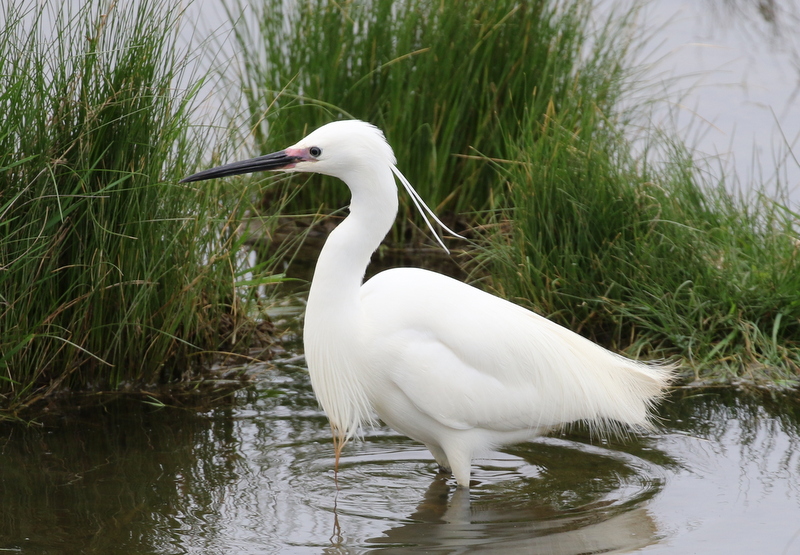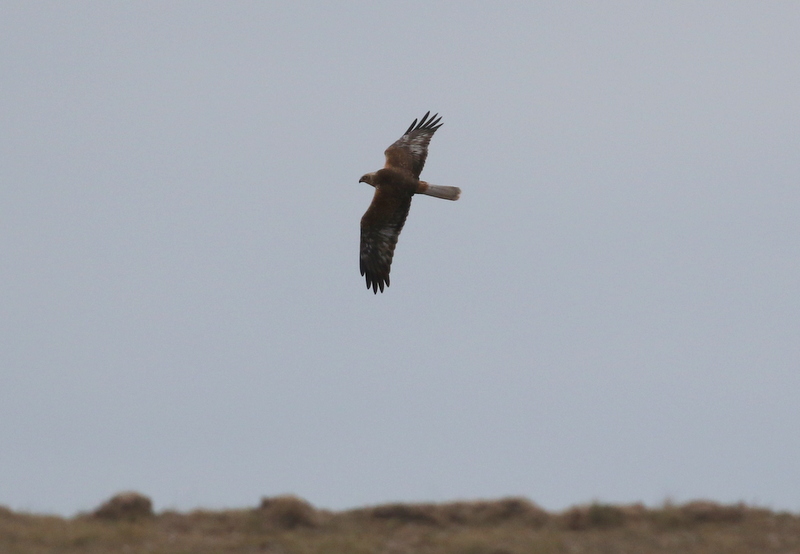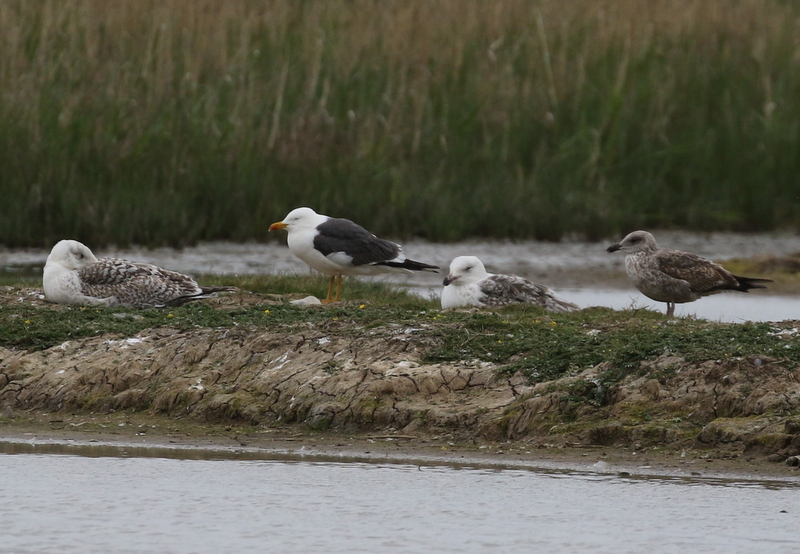Day 3 of a three day long weekend of Spring Tours today, our last day. It was another rather cold and windy day, still un-spring-like, but at least once again it was mostly dry, at least until we had finished at the end of the day. We met in Wells and headed east along the coast today.
Our first destination was Kelling. We had received a message to say some Yellow Wagtails had dropped in with the cows there, so we thought it might be worth a look, in case they might stop to feed for a while. As we parked in the village a couple of House Martins were prospecting nest sites under the eaves of the buildings there. A Coal Tit appeared in one of the fir trees by the school.
It was rather sheltered in the lane and there were warblers singing in the hedges. We could hear a couple of Chiffchaff singing on the walk down and a Blackcap was calling in the copse (it would have found its full voice by the time we walked back!). A Lesser Whitethroat rattled in the hawthorns and then flew across the lane in front of us, perching out in the open in the top of the hedge briefly.
As we got down to the Water Meadow, a couple of Skylarks were singing over the fields. There are always plenty of Rooks here and a pair of Carrion Crows down in the grass too gave us a good opportunity to talk about the differences between them. A Sedge Warbler was belting out its song from the top of the brambles, despite being exposed to the cold north wind out in the open here. As we approached, it flew up from its perch and parachuted down into the grass in the middle of the field beyond.
 Sedge Warbler – singing from the top of the brambles, despite the wind
Sedge Warbler – singing from the top of the brambles, despite the wind
The cows on the Water Meadow were huddled up in the lee of the hedge and most of them had sat down. Unfortunately there was no sign of any Yellow Wagtails with them – they had obviously continued on their way. From where we were standing we could hear a Grasshopper Warbler reeling, but it was obviously tucked down deep in the brambles today and we couldn’t see it before it went quiet again.
A steady stream of Sand Martins came to feed over the water, along with a few Swallows. There were a few ducks on the pool too – several Gadwall and Teal, a pair of Shoveler and a pair of Shelduck. We could hear a couple of Reed Warblers singing. The first, from the reeds by the track, was down low and not visible, but we found the second clambering around in the bushes, looking for food and singing as it did so.
We walked round to the beach in the hope that there might be some migrants on the move, but the skies overhead were quiet. A pair of Stonechats were feeding on the ground behind the beach, out of the wind, and there were a few Meadow Pipits here but nothing else. It was cold here in the wind, so we beat a hasty retreat.
Heading to the Heath next, we thought we would try our luck. Up on the ridge here, it can be cold and windswept in conditions like we had today. A Garden Warbler was singing in the car park, but it was deep in the thick blackthorn bushes and we couldn’t see it. As we walked up along the track, we could hear lots of other warblers singing – several Chiffchaff, Willow Warbler, Common Whitethroat and Blackcap.
We heard another Garden Warbler singing from a birch tree by the path and tracked the sound as it moved round in the leaves until it appeared briefly on the outside where we could see it. There were quite a few Garden Warblers singing and calling up on the Heath today, which are always great to hear.
Walking round through the territory of one of the pairs of Dartford Warblers, we couldn’t hear or see any sign of them. There were a few Linnets twittering in the gorse and we came across a pair of Stonechats, which quickly moved away as we appeared. There seemed to be small groups of schoolchildren hiking everywhere today, we saw them at Kelling and Cley as well, presumably doing something like Duke of Edinburgh’s Award expeditions. One group came crashing across the middle of the heath at this point with what we presumed were their teachers. They were obviously lost, it sounded like they couldn’t find the path, and one of the staff was having to carry his dog as when he put it down it clearly couldn’t walk on the spiky cut gorse! We decided to try a quieter spot.
There is a particular place where we have seen Woodlarks regularly in the last few weeks, so we decided to walk round via there. As we approached, we could see a Woodlark walking round on the ground. Through binoculars, we could see it was collecting bright green caterpillars – it had a bill full of them already. Presumably, it had young nearby to feed.
 Woodlark – collecting caterpillars to feed to its young
Woodlark – collecting caterpillars to feed to its young
Then a second Woodlark appeared close by, also with a bill full of the same green caterpillars. They were obviously a pair. We enjoyed a great view as we watched the two of them for several minutes as they walked around between the branches, looking for more. Eventually, one disappeared and the second flew up and landed out of view.
It seemed like it might be just too cold and windy for the Dartford Warblers today, but it is always a nice walk round the Heath anyway. We had stopped and were talking about the Heath when we heard a male Dartford Warbler singing a little further along the path from us. We hurried over and found it perched right on the top of some gorse.
 Dartford Warbler – singing from the top of the gorse, despite the cold wind
Dartford Warbler – singing from the top of the gorse, despite the cold wind
It dropped down before everyone could get onto it, but we waited a minute and remarkably the male Dartford Warbler came up and started singing again. This time everyone had a great look at it. When it dropped down again, we could just about see it working its way through the gorse. Then the Dartford Warbler came up onto the top of the gorse a third time, singing, this time even closer to us. Great stuff!
With great views of both Dartford Warbler and Woodlark this morning, we decided to head back. Three Common Buzzards were circling over the wood beyond the Heath, despite the lack of any sunshine. As we walked back, we could hear juvenile Linnets calling from deep in the gorse and we watched as the parents flew round and perched nearby. Another Garden Warbler was singing in the birches, but it was hard to get onto with all the leaves moving in the wind – we could just see it flicking round between branches from time to time.
Back at the car, we made our way over to Cley. It was just about lunchtime, so we stopped at the NWT visitor centre and ate our lunch. A flock of about 30 Black-tailed Godwits came up from the scrapes and flew off towards Blakeney Harbour. A Marsh Harrier drifted over from the reedbed, causing all the Avocets to start alarm calling. A Grey Heron stood motionless in the reeds.
Looking at the sightings board in the visitor centre, there didn’t seem to be much on the reserve today. There has been a dearth of spring migrant waders at Cley in the last week or so, which could be due to the weather or to the lingering impact of the saltwater inundation during the floods in January.
We decided to head over to Walsey Hills instead of going out to the hides. There had been a Wood Warbler here earlier, but no one seemed to know where it was when we arrived. A Pied Flycatcher was apparently showing occasionally in the pines on the top of the hill, so we thought we would look for that first. When we got up there, we discovered it was spending most of its time deep in the pines. We walked into the trees and could just see a shape flitting around occasionally, but clearly we were not going to be able to get a really good look at it.
At that point, a message came round that the Wood Warbler had reappeared, so we made our way back down to the footpath. It was difficult viewing with all the bushes, and quite a crowd of people in here. We got a quick view of it in the back of the trees, flitting around, but then it disappeared again. It was clearly going to be impossible for everyone to get a really good look at it, so we decided to move on and try something different.
The birds from the East Bank were a lot easier to see. A pair of Common Pochard and several Tufted Duck were on the pools in the reedbed, along with a noisy group of Greylags. A good number of Swifts have now arrived, but finding insects in this weather was presumably challenging, and we had great views of them as they zoomed around low over the pools and the bank. One came within a few inches of the head of one of the group!
 Common Swift – zooming around over the East Bank
Common Swift – zooming around over the East Bank
Over the other side of the bank, a couple of Lapwings were displaying over the grazing marshes, putting on quite a display, chasing each other and tumbling through the air, singing their distinctive song.
 Lapwings – displaying over the grazing marshes
Lapwings – displaying over the grazing marshes
It was the chicks which stole the show though. A lone female Lapwing was huddled down in the grass not far from the bank on the edge of some water. We could just see one small chick tucked in underneath it, while another was wandering around just behind them. It still looked a bit unsteady on its feet! Mum was paying surprisingly little attention to it.
 Lapwing and chick – the latter still a bit unsteady on its feet
Lapwing and chick – the latter still a bit unsteady on its feet
There were also a few Redshanks out on the grazing marshes. A little later, we watched one displaying, a male flying up with bowed wings fluttering, then dropping down to land next to the female who looked distinctly unimpressed. A couple of Black-tailed Godwits were feeding distantly on Pope’s Marsh.
As well as the usual ducks, three or four lingering Wigeon were grazing around the pools. They should be off on their way back to Russia for the breeding season soon. In contrast, the Little Egrets breed nearby, so they don’t have far to go. One was fishing in a small pool near the bank and we could see it had bright pink facial skin, an indication that it was in breeding condition. We also admired its ornate plumes.
 Little Egret – a breeding adult, with pink facial skin
Little Egret – a breeding adult, with pink facial skin
Two Marsh Harriers were circling over the reedbed at the back of Pope’s Marsh, but then flew over towards the East Bank, flushing everything on the grazing marshes as they went. A single Whimbrel came up from somewhere in the grass and flew off calling.
 Marsh Harrier – flew over the East Bank, flushing everything from the grazing marshes
Marsh Harrier – flew over the East Bank, flushing everything from the grazing marshes
There as a nice selection of birds on Arnold’s Marsh again today. A single Ringed Plover was on one of the islands with a little group of Dunlin. The latter were in various stages of moult into summer plumage, with spotted black belly patches. A Grey Plover in contrast looked to be pretty much there already, looking stunning with black face and belly and bright white spangled upperparts. A lone Knot was also in its orange summer plumage, and several of the Bar-tailed Godwits were too. There were a couple of Turnstone hiding in the saltmarsh vegetation and one of those looked stunning with its white face and chestnut upperparts.
Two small waders down towards the front of the saltmarsh were Little Ringed Plovers. Through the scope, we could see their golden yellow eye rings. The female was preening and appeared rather disinterested in the male’s display. He appeared to be trying to impress her with a potential nest scrape, bowing and sitting down in it, fanning his tail up in the air. She barely moved!
 Little Ringed Plover – showing off a potential nest scrape to an unimpressed female
Little Ringed Plover – showing off a potential nest scrape to an unimpressed female
There were no terns on Arnold’s Marsh today, but a quick look out at the sea produced two Sandwich Terns making their way west offshore. It was very breezy out on the beach, so we then beat a hasty retreat.
We had a quick look down at Iron Road to finish the day. There were lots of Gadwall on the pool here, but not much else of note. We looked up to see four Ruff flying off east. As we walked out towards Babcock Hide, there were plenty of geese on the grazing marshes – Greylags, Canada and a pair of Egyptian Geese. More of a surprise was a Fulmar flying west over the fields inland of the coast road!
A quick look out from the hide, and the scrape looked rather quiet. A single Common Sandpiper appeared, walking round the front of one of the islands, but then quickly flew off. Out at the back, we managed to find a single Ringed Plover and a single Little Ringed Plover. Otherwise, there were just a couple of Redshank to make up the waders.
There were a few of the regular ducks out on the pool, the most noteworthy being a male Common Pochard. More interesting were the gulls. Several immature (2cy & 3cy) Great Black-backed Gulls were sleeping on the islands, presumably on here to get away from the wind at the beach. In with them, we found a single adult Lesser Black-backed Gull and a 1st winter. The Lesser Black-backed Gulls were completely dwarfed by the Great Black-backs.
 Lesser Black-backed & Great Black-backed Gulls – roosting on the islands
Lesser Black-backed & Great Black-backed Gulls – roosting on the islands
Unfortunately it was time for us to start making our way back. As we walked back towards the car, we could hear Greenshanks calling, and looked up to see a flock of 8 flying high NE. They did not stop, presumably there is something about Cley which means it is not proving attractive to migrant waders at the moment.
As we drove back towards Wells, it started to drizzle. We had been lucky that it stayed dry pretty much all day again today. It had been another cold and windy day, but despite the conditions we had racked up a list of 90 species today. Not bad going, especially as we spent much of the day at rather specialised sites such as the Heath and Walsey Hills!
















